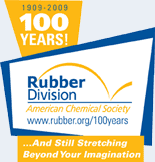![[ Visit ACS Rubber Website ]](images/logo.jpg) |
|
Centennial Elite SponsorsBecome a Centennial Elite Sponsor |
151 Passenger Tire Modeling and Sensitivity to Cap Ply and Steel Belt AlterationsThursday, October 15, 2009: 10:00 AM
326 (David L. Lawrence Convention Center )
Tire vehicle performance prediction at the conceptual level continues to save millions of dollars associated with the cost of several alternatives of mold manufacturing, several rubber moldings, and the many and exhaustive destructive tire testing. The saving can be viewed as reduction of the carbon footprint of the vehicle. Numerical simulation of tire behavior, i.e. noise, wet/dry traction, wear, rolling resistance, handling, is a credible trend as long as it provides the compulsory accuracy and precision. The improvement in algorithms, fast processing and computer storage render and reinforce this inclination. Nonlinearity in rubber material behavior, tire large deformation, and contact conditions still pose challenges to provide precise tire model for the tire/vehicle analyst to predict dynamic performances, i.e. noise, traction and handling, while it substitutes the manufacturing and testing by providing static analyses, including geometry conformity, contact patch determination, and inner layer and contact stresses. In this work an explicit FEM multi layer tire model is developed that accounts for fourteen different nonlinear materials and the linear elastic rim. The tire comprising materials were tested initially, and test results are used to establish the constitutive Mooney Rivlin material model. The tire model simulates mounting on a suitable rim, inflation pressure, and load and rolling speed, respectively. The model deformation and footprint shape was validated against static load setup, and contact patch experimental facilities that uses Tekscan load sensors. Furthermore, sensitivity analysis to the addition and deletion of cap ply located over the two steel belts, steel belt length, and their offset versus the gain/loss of the attained state of stresses will be presented.
|









